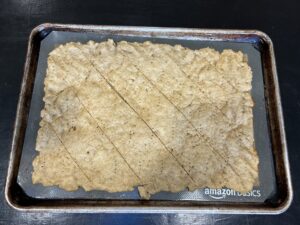Thoughts on the Feast of Unleavened Bread with Our Favorite Matzah Recipe
The Feast of Unleavened Bread often gets lumped in with and even called Passover, but it is, in fact, it’s own Appointed Time and Biblical Feast that essentially begins with the Passover meal and continues for seven days.
We are commanded to remove all traces of leaven from our homes before the Passover meal begins, and we are to remain leaven-free and partake of unleavened bread throughout the seven days of the feast. Many debate what exactly must be removed – do we have to throw out those little packets of yeast, our baking powder and baking soda, any dry mixes that contain them?
Because Hebrew is a verb-based language rather than a noun-based one like English, it’s actually the wrong question to ask what {noun} should be removed. When the Scripture says to remove the “yeast” from our homes, this is actually a very poor translation for us. Ancient peoples did not have the concept or the verbiage for the microorganisms we call “yeast.” They just knew that if they mixed flour and water together and left it out, it rose, and if they kept a lump from each batch to add to the next, it rose better and faster. It is the action or the process of leavening that is being referred to in the Scripture and that is to be removed from our homes and our lives. In the physical world, yeast is in the air and impossible to remove, but we can take measures to keep the process of leavening from occurring by keeping our flour dry and cooking all of it quickly once wet and dry have been mixed.
In the same way, spiritual leaven will also always be all around us in this fallen world, but we are training ourselves to take the actions necessary to keep it from doing its “leavening work” in our hearts. There will always be enticing temptations toward pride, sin, hypocrisy, and false teaching (all things leavening is linked to in the Bible), and we must learn not to let them take root in our hearts and to get rid of them if we notice they have begun to “bubble up” in us. And we certainly don’t hold onto any of our old ways to mix them in with the new.
This is the lesson of the Feast of Unleavened Bread.
It is a deception to think we can create an environment here on earth without any “leavening agents,” physical or spiritual, and this deception has led to many cults at its worst and, at its best, many children of believers falling away because they have never been trained in how to keep the spiritual “yeast” all around them from “leavening” their hearts and taking over their whole lives.
So what does this look like practically in my home? We get rid of anything that has gone through the process of leavening and is already baked and anything going through the process like a sourdough starter. Beyond that, I just aim to keep the process from happening throughout the week, which is really not that burdensome! My containers of yeast and baking powder remain unopened in the pantry for the week. I do not allow them or the yeast in the air of my home to do any leavening work this week.
Here is my favorite recipe for making my own unleavened bread. I work quickly and I don’t walk away from my dough during the process, but I do not time myself like the strictest Jews do. I know how long it takes for yeast in the air to act on my dough from what I make the rest of the year, so I’m confident that by mixing this dough and putting it straight into the oven, no leavening is taking place.
Our Favorite Matzah
Ingredients
Method
- Preheat oven to 450 degrees Fahrenheit.
- Grease 2 cookie sheets or line them with parchment paper or silicone mats.
- Mix all the ingredients, preferably in a stand mixer. You may need to add more liquid a tablespoon at a time, especially if you don't use the honey, until you reach dough consistency. If it gets too wet, add a little more flour. This recipe is very forgiving!
- Do not allow the dough to rest. Immediately divide it between the two pans and spread it evenly out to the edges of the pan like you would for pizza.
- Poke the dough with a fork and score stripes onto it with a knife. (This keeps it from puffing up but is also a visual reminder that He was pierced for our transgressions, and by His stripes, we are healed. The kids and I usually quote these verses together every time we do this step.)
- Bake for 12-14 minutes. I usually put one pan on each rack for 7 minutes and then switch them for the last 7 so they bake evenly.
- Let cool and then cut into whatever shapes you want.
I hope you have a wonderful Feast of Unleavened Bread, and I pray that this week of physical discipline spills over into all our lives to teach us how to handle all the spiritual “leaven” in the air around us! In the words of Paul in 1 Cor 5:7, “Clean out the old leaven so that you may be a new batch, just as you are, still unleavened. For Christ our Passover Lamb has been sacrificed.”








